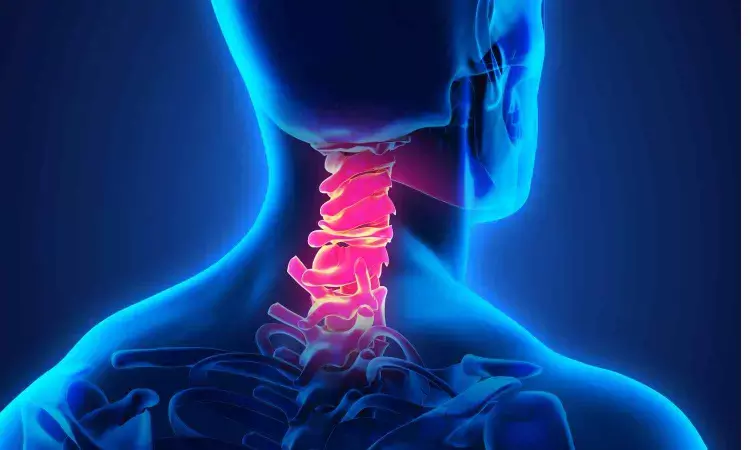- Home
- Medical news & Guidelines
- Anesthesiology
- Cardiology and CTVS
- Critical Care
- Dentistry
- Dermatology
- Diabetes and Endocrinology
- ENT
- Gastroenterology
- Medicine
- Nephrology
- Neurology
- Obstretics-Gynaecology
- Oncology
- Ophthalmology
- Orthopaedics
- Pediatrics-Neonatology
- Psychiatry
- Pulmonology
- Radiology
- Surgery
- Urology
- Laboratory Medicine
- Diet
- Nursing
- Paramedical
- Physiotherapy
- Health news
- Fact Check
- Bone Health Fact Check
- Brain Health Fact Check
- Cancer Related Fact Check
- Child Care Fact Check
- Dental and oral health fact check
- Diabetes and metabolic health fact check
- Diet and Nutrition Fact Check
- Eye and ENT Care Fact Check
- Fitness fact check
- Gut health fact check
- Heart health fact check
- Kidney health fact check
- Medical education fact check
- Men's health fact check
- Respiratory fact check
- Skin and hair care fact check
- Vaccine and Immunization fact check
- Women's health fact check
- AYUSH
- State News
- Andaman and Nicobar Islands
- Andhra Pradesh
- Arunachal Pradesh
- Assam
- Bihar
- Chandigarh
- Chattisgarh
- Dadra and Nagar Haveli
- Daman and Diu
- Delhi
- Goa
- Gujarat
- Haryana
- Himachal Pradesh
- Jammu & Kashmir
- Jharkhand
- Karnataka
- Kerala
- Ladakh
- Lakshadweep
- Madhya Pradesh
- Maharashtra
- Manipur
- Meghalaya
- Mizoram
- Nagaland
- Odisha
- Puducherry
- Punjab
- Rajasthan
- Sikkim
- Tamil Nadu
- Telangana
- Tripura
- Uttar Pradesh
- Uttrakhand
- West Bengal
- Medical Education
- Industry
Posterior surgery noninferior to anterior surgery for cervical radiculopathy, reveals study

For patients with cervical radiculopathy, posterior foraminotomy provides outcomes comparable to those of the more commonly performed anterior cervical discectomy, reports a randomized clinical trial in The Journal of Bone & Joint Surgery. The journal is published in the Lippincott portfolio by Wolters Kluwer.
"[O]ur findings provide Level-I evidence that posterior surgery is noninferior to anterior surgery with regard to the clinical outcome, with follow-up of two years," according to the new research by Nádia F. Simões de Souza, MD, and Anne E. H. Broekema, MD, PhD, of University Medical Center Groningen, the Netherlands, and colleagues.
Updated FACET report provides two-year follow-up data
Patients with cervical radiculopathy have pain, sensory, and/or motor deficits caused by spinal degenerative nerve root compression. The main options for surgical treatment are anterior cervical discectomy with fusion (ACDF) and posterior cervical foraminotomy. Because it occurs mainly in middle-aged to older adults – often in their working years – the incidence of cervical radiculopathy is expected to increase with the aging of the population.
Given the limited available evidence, there is ongoing debate regarding the choice between these two procedures. Previous results from the randomized Foraminotomy ACDF Cost-Effectiveness Trial (FACET) reported that posterior surgery was noninferior to anterior surgery at one-year follow-up. The new report extends the FACET findings to two years' follow-up.
The researchers analyzed primary outcome data for 236 patients with single-level cervical radiculopathy who were assigned to posterior foraminotomy or ACDF at nine Dutch hospitals. The main outcomes of interest were the surgical success ratio, based on Odom criteria (symptom improvement and ability to perform daily activities), and decrease in arm pain.
On extended follow-up, the outcomes of the two approaches remained similar. Two-year surgical success rate was 81% in patients assigned to posterior surgery and 74% to anterior surgery: the difference was within the specified noninferiority margin of 10 percentage points. The two groups also had similar reductions in arm pain, with a difference of three percentage points.
Choice of anterior or posterior surgery should be included in patient counseling
The procedures yielded similar improvement in secondary outcomes, including neck pain, disability, work ability, and quality of life, and treatment satisfaction. For most outcomes, change scores reached prespecified thresholds for clinically relevant improvement.
The two groups had similar rates of serious surgery-related adverse events (eight percent in the posterior and nine percent in the anterior group) including revision surgery.
The "demonstrated noninferiority" of posterior compared with anterior surgery is consistent with the findings of previous retrospective studies. Rates of recurrent symptoms and revision surgery were slightly higher after posterior surgery, although the trial was not powered to draw firm conclusions based on these outcomes. Posterior surgery also has some potential advantages: it involves fewer vital structures, avoids the need for implants, and has lower costs.
Drs. Simões de Souza and Broekema believe their findings have implications for discussions of treatment options for cervical radiculopathy. "As both procedures have similar clinical outcome profiles, the emphasis in patient counseling should be on the types of complications for each procedure, patient-specific factors, and potential sustainability," the researchers conclude. "Both physician and patient should individually weigh the advantages and disadvantages of both procedures."
Reference:
Simões de Souza, Nádia F. MD1,a,*; Broekema, Anne E.H. MD, PhD1,*; Reneman, Michiel F. PhD2; Koopmans, Jan MD, PhD3; van Santbrink, Henk MD, PhD4,5,6; Arts, Mark P. MD, PhD7; Burhani, Bachtiar MD, PhD8; Bartels, Ronald H.M.A. MD, PhD9; van der Gaag, Niels A. MD, PhD10,11,12; Verhagen, Martijn H.P. MD13; Tamási, Katalin PhD1,14; van Dijk, J. Marc C. MD, PhD1; Groen, Rob J.M. MD, PhD1; Soer, Remko PhD15,16; Kuijlen, Jos M.A. MD, PhD1; on behalf of the FACET investigators†. Posterior Cervical Foraminotomy Compared with Anterior Cervical Discectomy with Fusion for Cervical Radiculopathy: Two-Year Results of the FACET Randomized Noninferiority Study. The Journal of Bone and Joint Surgery ():10.2106/JBJS.23.00775, July 24, 2024. | DOI: 10.2106/JBJS.23.00775.
Dr Kamal Kant Kohli-MBBS, DTCD- a chest specialist with more than 30 years of practice and a flair for writing clinical articles, Dr Kamal Kant Kohli joined Medical Dialogues as a Chief Editor of Medical News. Besides writing articles, as an editor, he proofreads and verifies all the medical content published on Medical Dialogues including those coming from journals, studies,medical conferences,guidelines etc. Email: drkohli@medicaldialogues.in. Contact no. 011-43720751


